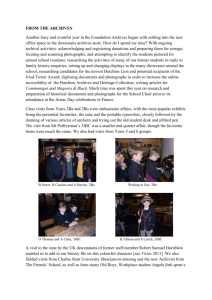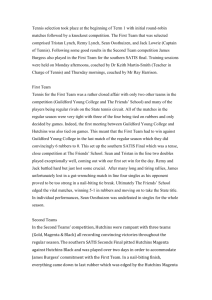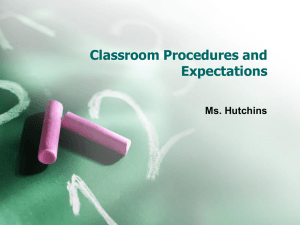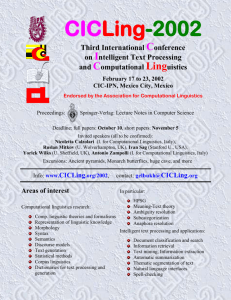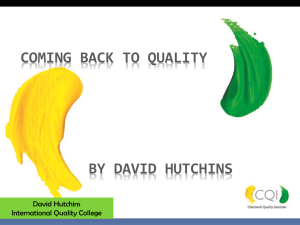Book Reviews: Machine Translation: Past, Present, Future
advertisement
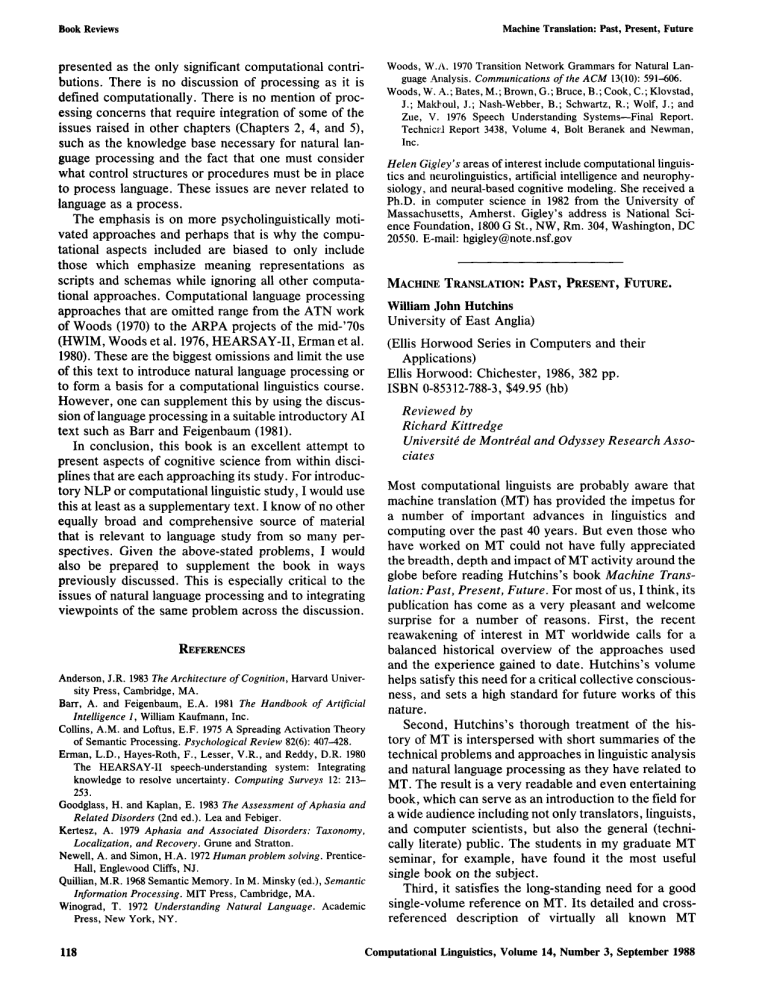
Book Reviews Machine Translation: Past, Present, Future Woods, W.i~. 1970 Transition Network Grammars for Natural Language Arlalysis. Communications of the ACM 13(10): 591-606. Woods, W. A.; Bates, M.; Brown, G.; Bruce, B.; Cook, C.; Klovstad, J.; Mal@oul, J.; Nash-Webber, B.; Schwartz, R.; Wolf, J.; and Zue, V. 1976 Speech Understanding Systems--Final Report. Technic~'.l Report 3438, Volume 4, Bolt Beranek and Newman, Inc. presented as the only significant computational contributions. There is no discussion of processing as it is defined computationally. There is no mention of processing concerns that require integration of some of the issues raised in other chapters (Chapters 2, 4, and 5), such as the knowledge base necessary for natural language processing and the fact that one must consider what control structures or procedures must be in place to process language. These issues are never related to language as a process. The emphasis is on more psycholinguistically motivated approaches and perhaps that is why the computational aspects included are biased to only include those which emphasize meaning representations as scripts and schemas while ignoring all other computational approaches. Computational language processing approaches that are omitted range from the ATN work of Woods (1970) to the ARPA projects of the mid-'70s (HWlM, Woods et al. 1976, H E A R S A Y - I I , Erman et al. 1980). These are the biggest omissions and limit the use of this text to introduce natural language processing or to form a basis for a computational linguistics course. H o w e v e r , one can supplement this by using the discussion of language processing in a suitable introductory AI text such as Barr and Feigenbaum (1981). In conclusion, this book is an excellent attempt to present aspects of cognitive science from within disciplines that are each approaching its study. For introductory N L P or computational linguistic study, I would use this at least as a supplementary text. I know of no other equally broad and comprehensive source of material that is relevant to language study from so many perspectives. Given the above-stated problems, I would also be prepared to supplement the book in ways previously discussed. This is especially critical to the issues of natural language processing and to integrating viewpoints of the same problem across the discussion. Helen Gigley's areas of interest include computational linguis- tics and neurolinguistics, artificial intelligence and neurophysiology, and neural-based cognitive modeling. She received a Ph.D. in computer science in 1982 from the University of Massachusetts, Amherst. Gigley's address is National Science Foundation, 1800 G St., NW, Rm. 304, Washington, DC 20550. E-mail: hgigley@note.nsf.gov MACHINE TRANSLATION: PAST, PRESENT, FUTURE. William John Hutchins University of East Anglia) (Ellis H o r w o o d Series in Computers and their Applications) Ellis Horwood: Chichester, 1986, 382 pp. ISBN 0-85312-788-3, $49.95 (hb) R e v i e w e d by Richard Kittredge Universit( de Montreal and Odyssey R e s e a r c h Associates REFERENCES Anderson, J.R. 1983 The Architecture of Cognition, Harvard University Press, Cambridge, MA. Barr, A. and Feigenbaum, E.A. 1981 The Handbook of Artificial Intelligence 1, William Kaufmann, Inc. Collins, A.M. and Loftus, E.F. 1975 A Spreading Activation Theory of Semantic Processing. Psychological Review 82(6): 4(17--428. Erman, L.D., Hayes-Roth, F., Lesser, V.R., and Reddy, D.R. 1980 The HEARSAY-II speech-understanding system: Integrating knowledge to resolve uncertainty. Computing Surveys 12: 213253. Goodglass, H. and Kaplan, E. 1983 The Assessment of Aphasia and Related Disorders (2nd ed.). Lea and Febiger. Kertesz, A. 1979 Aphasia and Associated Disorders: Taxonomy, Localization, and Recovery. Grune and Stratton. Newell, A. and Simon, H.A. 1972Human problem solving. PrenticeHail, Englewood Cliffs, NJ. Quillian, M.R. 1968 Semantic Memory. In M. Minsky (ed.), Semantic Information Processing. MIT Press, Cambridge, MA. Winograd, T. 1972 Understanding Natural Language. Academic Press, New York, NY. 118 Most computational linguists are probably aware that machine translation (MT) has provided the impetus for a number o f important advances in linguistics and computing over the past 40 years. But even those who have worked on MT could not have fully appreciated the breadth, depth and impact of M T activity around the globe before reading Hutchins's book Machine Translation: Past, Present, Future. F o r most of us, I think, its publication has come as a very pleasant and welcome surprise for a number of reasons. First, the recent reawakening of interest in MT worldwide calls for a balanced historical overview of the approaches used and the experience gained to date. Hutchins's volume helps satisfy this need for a critical collective consciousness, and sets a high standard for future works of this nature. Second, Hutchins's thorough treatment of the history of MT is interspersed with short summaries of the technical problems and approaches in linguistic analysis and natural language processing as they have related to MT. The result is a very readable and even entertaining book, which can serve as an introduction to the field for a wide audience including not only translators, linguists, and computer scientists, but also the general (technically literate) public. The students in my graduate MT seminar, for example, have found it the most useful single book on the subject. Third, it satisfies the long-standing need for a good single-volume reference on MT. Its detailed and crossreferenced description of virtually all known MT Computational Linguistics, Volume 14, Number 3, September 1988 Book Reviews projects (to 1985), including a chronological table of main projects and systems, its 33-page bibliography, and its index all contribute to make it the definitive reference work on MT today. Whatever shortcomings may be found in this book (see below) are relatively minor when compared to Hutchins's impressive achievement. Working largely on the basis of published documents and technical reports augmented by personal correspondence, Hutchins has pieced together a remarkable historical overview of the approaches and accomplishments of some 70 different MT projects and systems. Here one can find, for example, a whole chapter devoted to "Groups and projects in the Soviet Union and Eastern Europe (1955-1967)" as well as an account of the story behind the ALPAC report, notes on the origin of purported MT "howlers" (such as "out of sight, out of mind" translated as "invisible lunatic") and other lore. Machine Translation deals primarily with the wellestablished past. It is, in Hutchins's words "a history and assessment of efforts to mechanise processes of translating from one natural language into another." The final chapter, on "present developments and future prospects", highlights artificial intelligence approaches and increasing commercial activity, including work on translators' aids. The main thrust, however, is historical, with nearly half the book detailing the widespread activity that preceded the publication of the ALPAC report in 1966. Hutchins has done a historian's work. He traces MT's intellectual origins from 17th-century notions of a universal language. We hear about two 1933 patents for translation machines by French and Russian inventors, and are treated to a fascinating account of the early post-war period. A substantial chapter on "problems, methods and strategies" then outlines the background issues in semantics, syntax, and morphology and introduces the basic design options for MT systems. The remaining chapters are organized roughly according to decades. A 50-page chapter covers the U.S. scene through 1966, when dozens of American MT projects sprouted like mushrooms, only to wither away in disappointment or digress into linguistic theory or the computational prerequisites of sentence parsing. Chapters 5-7 recount the parallel activities in Western Europe, Eastern Europe, and the Orient (plus Mexico) during the decade ending in 1966. Chapter 8 details the stocktaking of the mid-1960s culminating in the devastating ALPAC report. The ALPAC watershed is also reflected in the book's structure. Chapter 9 sets the stage for the post-ALPAC era by surveying the strategies and methods introduced after 1966. Chapters 10 and 11 deal with interlingual systems and other indirect systems between 1965 and 1975, including the early work at Grenoble and Texas and on Mel'6uk's Meaning-Text Model. The operational systems of Systran, Logos, and the Pan American Machine Translation: Past, Present, Future Health Organization are treated together in a chapter on direct translation models. Another substantial chapter on transfer systems contains the main presentation of the TAUM, SUSY, GETA, and METAL project achievements. Chapter 14 is devoted to the use of Systran by the Commission of the European Communities, and to the growth of the Eurotra project. Chapter 15 covers the birth of "artificial intelligence systems" starting with Wilks at Stanford, and including the experiments of Schank and his students at Yale, and Nirenburg when at Colgate. The following chapter on recent interlingual projects introduces DLT and its use of Esperanto. Chapter 17, on interactive and human-aided systems, presents, among others, the Brigham Young University approach and its two commercial implementations at ALPS and WCC (Weidner). The penultimate chapter is devoted to work in the USSR and Japan since 1974. The fact that a mere eight pages here serve to cover a decade of Japanese effort is due more to the relative scarcity of Japanese tech reports in English in 1985 than to the state of the art in Japan at that time. I found Machine Translation to be quite fair and accurate, on the whole, in historical details that I have been able to verify. Hutchins has been careful to use original quotations from published material where claims might be open to debate. But the necessity of relying on printed sources can give an incomplete perspective on some projects. In the case of the Montreal TAUM project, for example, the documents available to Hutchins did not reveal the importance of the linguistic inspiration for the systems coming from the University of Pennsylvania school of distributional analysis and surface structure transformationalism (Z. Harris et al.). Although the implemented models for TAUM73, TAUM-METEO, and AVIATION were theoretically eclectic (borrowing insights from Fillmore's case grammar, as well as from Chomsky and Tesni~re), there was a strong link between the Pennsylvaniatrained linguists at TAUM and the N Y U practitioners of string grammar and sublanguage analysis (Sager et al.), who had also come from the Pennsylvania school. The influence of the Grenoble CETA/GETA group on TAUM, cited by Hutchins, was therefore limited mostly to broad questions of MT strategy during the years 1965-68, after which the two projects developed along independent lines, albeit in close communication. Some current MT researchers may feel that Hutchins places too much emphasis on the more distant past. (For example, fully half of the bibliographical references are to work published before 1968.) To some extent this is simply a function of the quantity of early work published. But it is also indicative of the quality of work by scores of talented people on MT in the 1950s and 1960s and of the rapid evolution taking place in linguistics and computer science. Hutchins reminds us of the distinguished linguists who cut their analytical teeth on MT problems, or in MT-funded laboratories: Noam Chomsky, Charles Fill- Computational Linguistics, Volume 14, Number 3, September 1988 119 Book Reviews more, Joseph Grimes, M.A.K. Halliday, Susumo Kuno, Sidney Lamb, John Lyons, James McCawley, and Igor Mel'~uk, to name but a few. Some of the advances in computing which resulted largely from work in MT laboratories include the foundations of formal language theory (Chomsky at MIT), ATN parsers (Woods at Harvard), and Prolog (from Colmerauer's Q-systems at Montreal). Purists might object to the condensed treatment that Hutchins (necessarily) gives to topics in linguistics and computing. In general, I found these summaries quite fitting and accurate, given the context. Only on a few occasions, such as on page 48, where Hutchins seems, by implication, to equate phrase structure grammars with finite state grammars, would I have liked to see the passage extended or reformulated. Another possible criticism might arise in the qualitative selection of references. Hutchins has apparently made an effort not to slight any significant contributor to the field, particularly where a new project or approach is involved. At the same time, those who have argued against MT in favor of machine aids for translators are not cited, presumably because Hutchins states at the outset that machine-aided human translation is 120 Machine Translation: Past, Present, Future outside lhe scope of Machine Translation. Still, a reference to Martin Kay's numerous and persuasive suggestiens over the years regarding the translatormachine interface would have been appropriate, given the pres~nt trends towards interactive systems and translator workstations. Another minor gap is the lack of any reference to COLING conferences or COLING proceedings before 1982, when in fact COLING has been the major forum for MT discussion and the conference proceedings still are a primary source of MT project information. Despite minor drawbacks of the kind mentioned above, Hutchins's book stands as a major achievement. It is generally balanced and objective, as complete as one could want, and throughly informative and readable. It should enjoy wide readership, particularly if it can be brought out in a less expensive student's edition. Even at the hardcover price, anyone seriously interested in MT cannot afford to be without this book. Richard Kittredge was one of the principals of the TAUM machine translation project. His address is: D6partement de Linguistique, Universit6 de Montr6al, C.P. 6128, Succ. A, Montr6al, Qufbec, Canada H3C 3J7. Computational Linguistics, Volume 14, Number 3, September 1988


